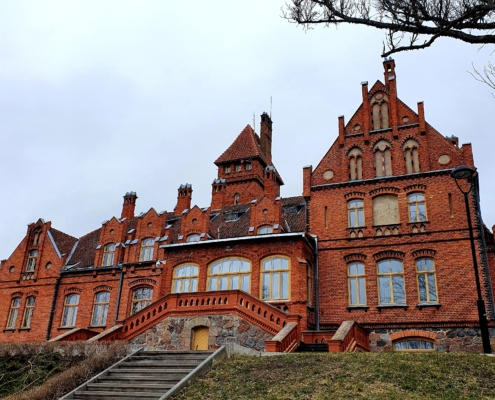 Jaunmoku Castle is a masterpiece of architecture in Latvia, designed in a combination of neo-Gothic style and modern. The palace was built in 1901 as a hunting castle and a summer residence for the mayor of Riga, George Armitsted (1847 – 1912). The sculpture of J. Armistead with a dog can be seen in Riga opposite the Opera and Ballet Theater. Jaunmoku Castle is one of the most famous and beautiful brick buildings in Latvia. The interior of the castle in the style of a hunting castle was re-created at the end of the 20th century, however, among the original interior items, tiled stoves of the castle deserve special attention, one of which was created at the turn of the 19-20 centuries in honor of the 700th anniversary of Riga, and on which you can see the painting from Images of Riga and its environs a hundred years ago.
Jaunmoku Castle is a masterpiece of architecture in Latvia, designed in a combination of neo-Gothic style and modern. The palace was built in 1901 as a hunting castle and a summer residence for the mayor of Riga, George Armitsted (1847 – 1912). The sculpture of J. Armistead with a dog can be seen in Riga opposite the Opera and Ballet Theater. Jaunmoku Castle is one of the most famous and beautiful brick buildings in Latvia. The interior of the castle in the style of a hunting castle was re-created at the end of the 20th century, however, among the original interior items, tiled stoves of the castle deserve special attention, one of which was created at the turn of the 19-20 centuries in honor of the 700th anniversary of Riga, and on which you can see the painting from Images of Riga and its environs a hundred years ago.
There are two options for the appearance of the name of the castle. The first – not far from this place is the Karatavskaya hill, on which in ancient times the baron punished his subjects. From here comes the stream of martyrs. The second option – the word “jaunmokas” in the Prussian dialect means “new fields”, which the landowner once acquired in this place.
George Armitsted owned the Jaunmokas Palace and Manor until 1904. After the death of his father, George inherited the Rindzele estate and sold the castle to Jaunmoku to the Brinkens family, who owned the castle until 1910. After that, the owners of the palace changed very often. In 1920, Latvia nationalized the castle, and until 1940 it was used as a sanatorium for children. During World War II, the Russian and German armies used the castle as a military school, radio station and hospital. After the war, the palace was used as a base for machine and tractor reclamation (soil improvement and drainage) and a warehouse for agricultural machinery. Also, 20 families lived in the castle, which still housed a store, cinema and dance halls.
In 1974, the building was transferred to the Ministry of Forestry, and after 20 years of intensive reconstruction, Jaunmoku Castle was completely restored. The castle has an exposition about forestry and hunting in Latvia. Theatrical excursions, organization of holidays are also offered, there is a cafe, playgrounds. A very beautiful view opens from the observation tower. Jaunmoku Castle has its own legend and its own ghost, communication with which was documented by scientists from Germany.
Legend of Jaunmoku Castle
The legend of Jaunmokas Palace is based on real events that took place at the beginning of the 20th century and the legend tells us a story about a young girl named Dorothy.
At the end of the 20th century, relatives of the former owner of the palace, von Ungern – Sternberg visited the palace and after this visit we received a letter from them in which the tragic incident described what happened at the beginning of the 20th century.
The German army lived in the palace during World War II. At this time, a young girl Dorothy worked as a nanny in the palace. Dorothy fell in love with an officer, but the army did not stay long in one place. After some time, the officer left the palace with the army, leaving the girl who was expecting a child. Dorothy could not stand the breakup and she did not want to be ashamed when everyone finds out her secret, so at night Dorothy went to a pond near the palace and ended her life by jumping into the water.
After this tragic event, the inhabitants of the palace sometimes saw a mysterious ghost, with a white dress that wandered around the palace. Dorothy’s spirit found no peace.
People who lived and worked in the palace say that they often heard and saw the White Lady who walked around the palace or slammed the door.
Not every visitor can see the White Lady, but who knows … Maybe if you visit the Jaunmokas Palace, or stay here for the night, you will witness her presence.







